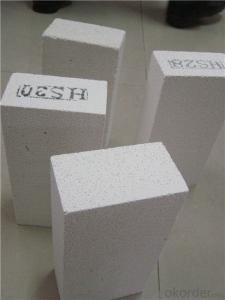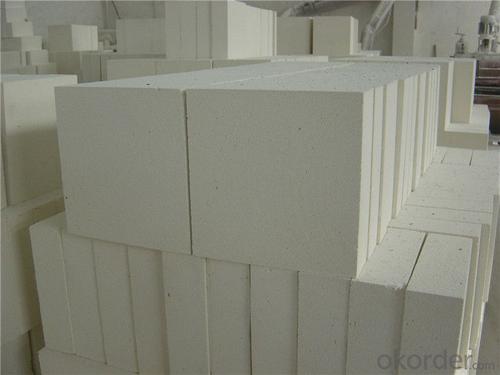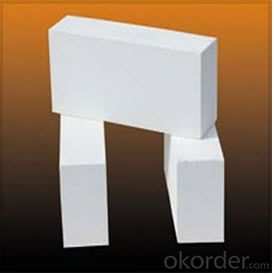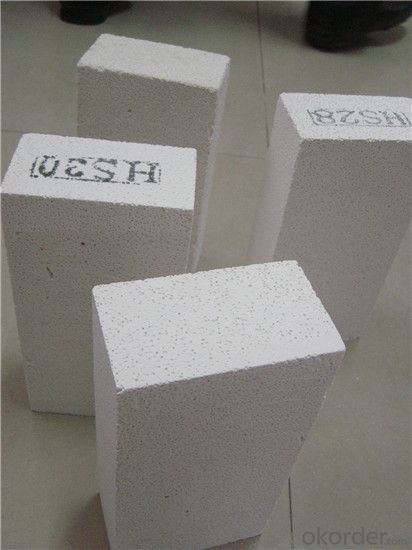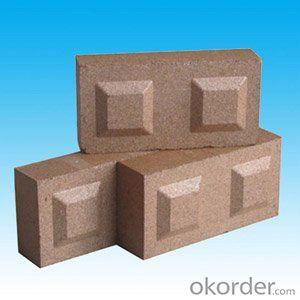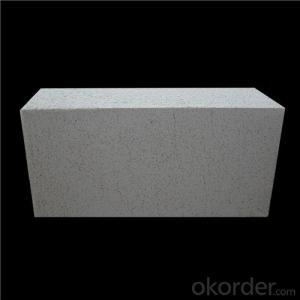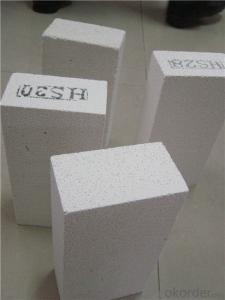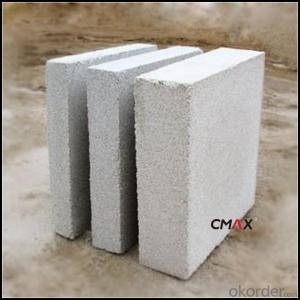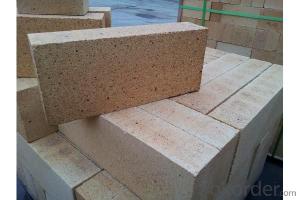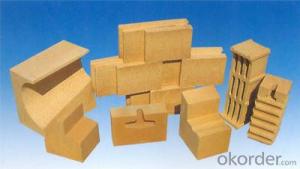High Temperature Insulating Fire Brick for Blast Furnace
- Loading Port:
- Shanghai
- Payment Terms:
- TT OR LC
- Min Order Qty:
- 1 m.t.
- Supply Capability:
- 1000 m.t./month
OKorder Service Pledge
OKorder Financial Service
You Might Also Like
Thermal Insulation Fire Clay Brick
Refractory brick is a block of refractory ceramic material used in lining furnaces, kilns, fireboxes, and fireplaces.
We provide high quality Refractory Fire Bricks that are used on wide range in the various industries like Cement, Glass and Steel. Refractory Fire Bricks are provided as per the quantity and specifications required by the customers. We provide an extensive range of Refractory Fire Bricks at reasonable prices that depend upon the quantity ordered.
Application
Insulating Fire Brick are used for the lining of converter, alternating current arc furnace, direct Current arc furnace and the ladle slag line, etc.
Company Advantage
(1)Long Insulating Fire Brick manufacture history: 25 years manufacturer
(2)Advanced equipment
(3)Diversification of production standards: ISO ANSI FEPA JIS ASTM
(4)Flexible payment: T/T L/C D/P D/A
(5)Professional marketing team and after-sale service
Insulating Fire Brick main feature:
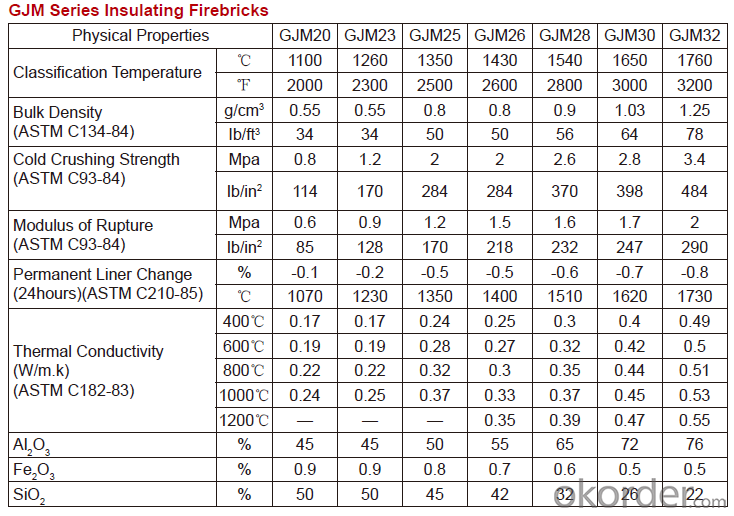
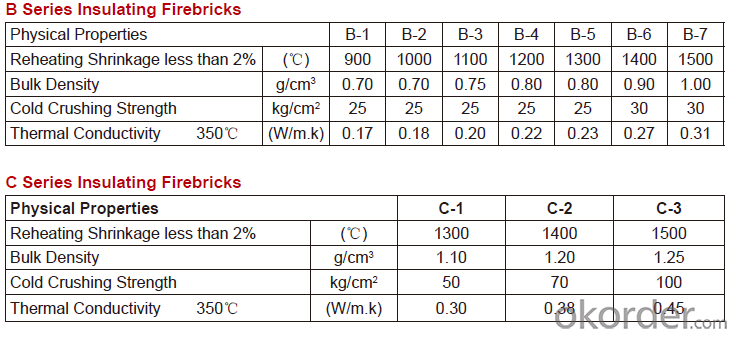
Equipment
1 unit of Ceramic Abrasive (SG Abrasive) pilot production line
2 units of Compact grain Abrasive pilot production lines
1 unit of high-end coated abrasives (abrasive cloth) production line
2 units of Boron Carbide production lines
3 large flexible crushing and sieving lines for grit production lines
6 units of 5000KVA-10000KVA dumping type electric arc furnaces for Brown Fused Alumina fusion
Q1 What’s the transport method?
A1 FCL delivery goods with wooden pallet or wooden case by sea; If LCL delivery, must with wooden case; Sometimes need open top, flat rack or bulk cargo.
Q2 What’s the required payment term?
A2 Generally 30% TT as the prepayment, 70% TT before delivery. If need, 100% Irrevocable Letter of Credit or negotiation.
Q3 Which country are our products exported to?
A3 Apart from entire Chinese market, the US, Russia, Japan, Korea, Australia and some Southeast Asian Nations.
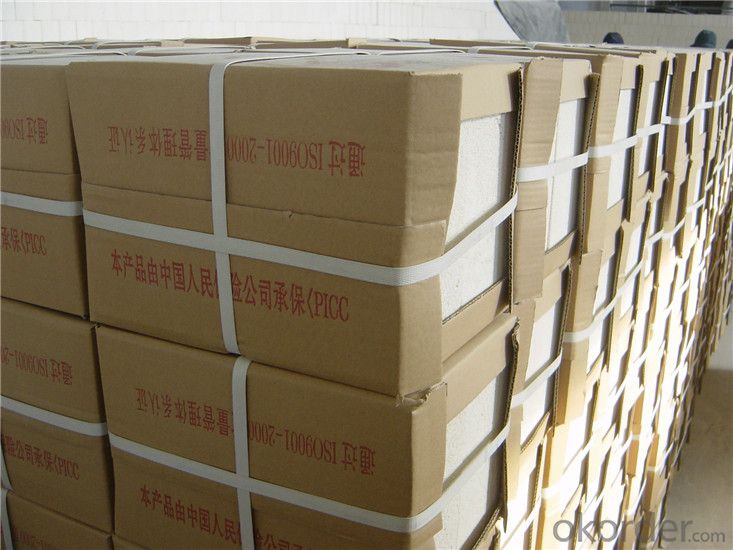

- Q: Can insulating fire bricks be used for insulation in solar thermal systems?
- Yes, insulating fire bricks can be used for insulation in solar thermal systems. Insulating fire bricks are specially designed to have low thermal conductivity, which means they can effectively trap and retain heat. This makes them suitable for insulating the components of a solar thermal system, such as the solar collector and the storage tank, to minimize heat loss and increase the overall efficiency of the system. Additionally, insulating fire bricks are able to withstand high temperatures, which is crucial in solar thermal systems where temperatures can reach extremes. Overall, using insulating fire bricks for insulation in solar thermal systems can help improve their performance and reduce energy loss.
- Q: Can insulating fire bricks be used in metal smelting furnaces?
- Yes, insulating fire bricks can be used in metal smelting furnaces. Insulating fire bricks are designed to have low thermal conductivity, which means they can effectively retain heat and prevent heat loss from the furnace. This makes them ideal for use in metal smelting furnaces, where high temperatures need to be maintained for extended periods of time. Additionally, insulating fire bricks are resistant to thermal shock and can withstand the harsh conditions and rapid temperature changes that occur during metal smelting processes. They are also lightweight, making them easier to handle and install in the furnace. Overall, insulating fire bricks are a suitable choice for use in metal smelting furnaces to improve energy efficiency and increase the lifespan of the furnace.
- Q: Can insulating fire bricks be used in the construction of fireplaces?
- Yes, insulating fire bricks can be used in the construction of fireplaces. These types of bricks are designed to withstand high temperatures and provide insulation, making them ideal for lining the interior of fireplaces. They help to retain heat, improve energy efficiency, and protect the surrounding materials from excessive heat.
- Q: The structural specification does not indicate that masonry needs insulation bricks. Is it necessary to use insulation bricks?
- Look at the exterior wall insulation design, construction practices and related requirements
- Q: Are insulating fire bricks suitable for insulation in petrochemical plants?
- Yes, insulating fire bricks are suitable for insulation in petrochemical plants. These bricks are made from lightweight refractory materials and have excellent thermal insulation properties. They can withstand high temperatures and provide insulation against heat transfer, making them ideal for use in petrochemical plants where insulation is crucial for safety and energy efficiency.
- Q: Are insulating fire bricks suitable for use in glass furnaces?
- Yes, insulating fire bricks are indeed suitable for use in glass furnaces. These fire bricks are specifically designed to withstand high temperatures and provide excellent thermal insulation. They help to maintain consistent heat levels within the furnace, prevent heat loss, and reduce energy consumption. Additionally, insulating fire bricks are resistant to chemical reactions and can withstand the corrosive environment of a glass furnace.
- Q: The difference between ordinary and diatomite brick refractory brick
- Insulation products made from diatomaceous brick and porous diatomite. The main raw material is natural porous diatomite, and then a small amount of clay and fuel are added. The volume density of diatomite brick was 0.7g/cm3, compressive strength at room temperature is 1 ~ 2MPa, the coefficient of thermal conductivity at 400 C for 0.13 ~ 0.20W/ (M - K), the apparent porosity is greater than 70%, the coefficient of thermal expansion (1280 degrees) 0.9 x 10 - 6 DEG -1, refractoriness is greater than 1250 DEG C. Mainly used in industrial kilns and other thermal equipment, thermal pipes insulation materials, generally withstand the hot surface temperature of about 1000 degrees celsius. Mainly used in industrial kilns and other thermal equipment, thermal pipes insulation materials, generally withstand the hot surface temperature of about 1000 degrees celsius.
- Q: Can insulating fire bricks be used in the construction of heat storage systems?
- Insulating fire bricks have the potential to be utilized in the construction of heat storage systems. These bricks are specifically designed to possess low thermal conductivity, enabling them to effectively trap and retain heat. They are typically composed of materials such as fire clay, which possess exceptional insulation properties. By incorporating insulating fire bricks, it becomes feasible to minimize heat loss, thereby facilitating efficient heat storage and retention within the system. These bricks can be employed to construct the walls and lining of the heat storage system, ensuring that the stored heat does not dissipate into the surroundings. Furthermore, insulating fire bricks are lightweight and easily manageable, rendering them a convenient option for the construction of heat storage systems. Ultimately, the utilization of insulating fire bricks significantly enhances the thermal efficiency of heat storage systems, consequently contributing to more effective heat management.
- Q: Can insulating fire bricks be used in the construction of thermal insulation walls?
- Yes, insulating fire bricks can be used in the construction of thermal insulation walls. These bricks are designed to have low thermal conductivity, which helps to minimize heat transfer. They are widely used in applications where thermal insulation is required, including the construction of walls and other structures that need effective insulation against high temperatures.
- Q: Can insulating fire bricks be used in heat exchangers?
- Yes, insulating fire bricks can be used in heat exchangers. Insulating fire bricks are designed to have excellent thermal insulation properties, which makes them suitable for use in high-temperature applications such as heat exchangers. These bricks are made from lightweight materials and have low thermal conductivity, allowing them to effectively reduce heat loss or gain in the heat exchanger. Additionally, insulating fire bricks have high resistance to thermal shock and can withstand extreme temperatures, making them a reliable choice for heat exchanger applications. Overall, using insulating fire bricks in heat exchangers can contribute to improved energy efficiency and performance.
Send your message to us
High Temperature Insulating Fire Brick for Blast Furnace
- Loading Port:
- Shanghai
- Payment Terms:
- TT OR LC
- Min Order Qty:
- 1 m.t.
- Supply Capability:
- 1000 m.t./month
OKorder Service Pledge
OKorder Financial Service
Similar products
Hot products
Hot Searches
Related keywords


